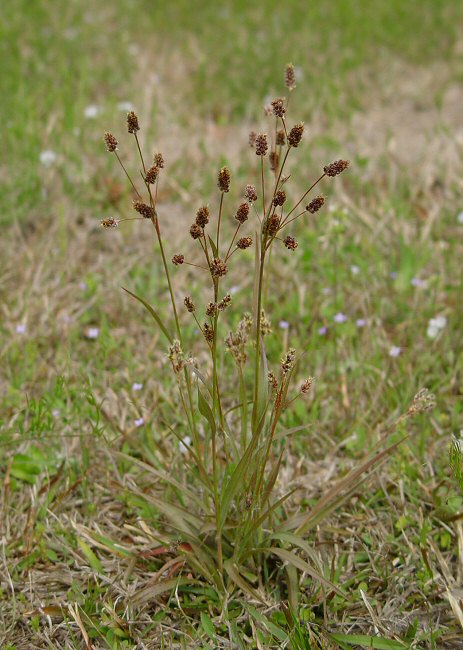Luzula campestris (L.) DC.
Wood Rush

Native
CC = 4
CW = 3
MOC = 55
© DETenaglia
Luzula campestris (L.) DC.Wood Rush | |
 |
Native CC = 4 CW = 3 MOC = 55 |
© DETenaglia |
|
Family - Juncaceae Habit - Perennial forb, usually with short rhizomes, often with white, bulblike offsets along the rhizome, the aboveground growth loosely or densely caespitose. Stems - Erect, to 50 cm, 1-5 per plant. Leaves - Basal leaves few to numerous, 5-25 cm long, 2-6 mm wide, linear to linear-lanceolate, flat, the tips pointed, thickened, the margins with few to numerous clumps of long, loosely spreading hairs, the surfaces glabrous. Leaves of aerial stems 1-3 per stem, similar to the basal leaves, but with short, closed sheaths at the base, 3-10 cm long, grading into the bracts of the inflorescence.
Inflorescences - Terminal umbels or panicles of dense, ovoid flower clusters. Clusters to 9 mm long, 5-7 mm in diameter, nearly sessile or with stalks of varying lengths, the stalks ascending or spreading to deflexed. Flowers each subtended by 2 small, triangular bracts 1-2 mm long, these unevenly toothed along the margins. Bracts at the base of the peduncles foliaceous, shorter than the peduncles. Flowers sessile, about 20 per cluster. Central cluster of the inflorescence often sessile.
Flowers - Sepals and petals 3, 2-4 mm long, green at the base, shiny chestnut-brown and with scarious margins apically, acuminate, erect. Stamens 6, opposite the petals and sepals, erect. Filaments green, glabrous, 0.3 mm long. Anthers yellow, 1 mm long. Ovary superior, globose-ovoid, green, glabrous, 0.6 mm long, 0.6 mm in diameter in flower, 3-locular. Style 1, glabrous, green. Stigmas 3, 1 mm long.
Fruits - Capsules 1.8-2.3 mm long, shorter than the perianth, obovoid to ellipsoid, the tip broadly rounded, straw-colored to dark brown. Seeds 3 per fruit, 1.0-2.5 mm long, ellipsoid to ovoid, dark brown, with a lighter-colored, straight or curved, caplike caruncle.
Flowering - April - June. Habitat - Dry upland forests, mesic upland forests in ravines, upland prairies. Mostly commonly on chert, sandstone, or granite. Origin - Native to U.S. Lookalikes - Broadly, numerous other graminoids. Other info. - This species is found in the southern half of Missouri. It is recognized by the characteristic appearance of the inflorescences, and the long, white hairs on the leaf margins. Photographs taken in Brown Summit, NC., 4-6-03, and off Hwy 82 near Hector, AL., 3-18-06 (DETenaglia). |